Related Research Articles

Looney Tunes is an American animated franchise produced and distributed by Warner Bros. It began as a series of short films that originally ran from 1930 to 1969, concurrently with its partner series Merrie Melodies, during the golden age of American animation. Following a revival in the late 1970s, new shorts were released as recently as 2014. The two series introduced a large cast of characters, including Bugs Bunny, Daffy Duck, and Porky Pig. The term Looney Tunes has since been expanded to also refer to the characters themselves.

Porky Pig is an animated character in the Warner Bros. Looney Tunes and Merrie Melodies series of cartoons. He was the first character created by the studio to draw audiences based on his star power, and the animators created many critically acclaimed shorts featuring the character. Even after he was supplanted by later characters, Porky continued to be popular with moviegoers and, more importantly, the Warners directors, who recast him in numerous everyman and sidekick roles.

Speedy Gonzales is an animated cartoon character in the Warner Bros. Looney Tunes and Merrie Melodies series of cartoons. He is portrayed as "The Fastest Mouse in all Mexico" with his major traits being the ability to run extremely fast, being quick-witted and heroic while speaking with an exaggerated Mexican accent. He usually wears a yellow sombrero, white shirt and trousers, and a red kerchief, similar to that of some traditional Mexican attires. To date, there have been 46 theatrical shorts made either starring or featuring the character.
Charlie Dog is an animated cartoon character in the Warner Brothers Looney Tunes series of cartoons. The character was featured in nine cartoons between 1941 and 1958. He is generally characterized as a friendly wise guy.
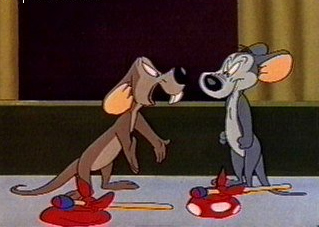
Hubie and Bertie are animated cartoon rodent characters in the Warner Bros. Looney Tunes and Merrie Melodies series of cartoons. Hubie and Bertie represent some of animator Chuck Jones' earliest work that was intended to be funny rather than cute. Seven Hubie and Bertie cartoons were produced between 1943 and 1952.

Gold Diggers of '49 is a 1935 Warner Bros. theatrical animated cartoon short in the Looney Tunes series.

Scaredy Cat is a 1948 Warner Bros. Merrie Melodies cartoon directed by Chuck Jones. The short was released on December 18, 1948, and stars Porky Pig and Sylvester the Cat. The cartoon is notable in that it marks the first time the name "Sylvester" is used for the popular feline character. In previous shorts, the cat is unnamed, except for in the 1947 cartoon Tweetie Pie in which he is referred to as "Thomas".

Porky's Badtime Story is a 1937 Warner Bros. Looney Tunes cartoon directed by Robert Clampett and an uncredited Chuck Jones. The short was released on July 24, 1937, and stars Porky Pig and Gabby Goat. The short was later remade as Tick Tock Tuckered (1944), with Daffy Duck taking Gabby's role.

Daffy Duck's Quackbusters is a 1988 animated compilation film featuring classic Warner Bros. Cartoons shorts and animated bridging sequences, starring Daffy Duck. The film was released to theaters by Warner Bros. on September 24, 1988. It was the final theatrical production in which Mel Blanc provided the voices of the various Looney Tunes characters before his death in July 1989.
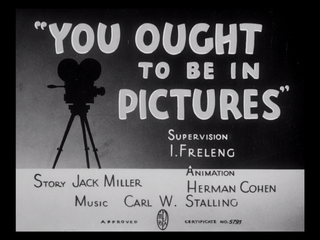
You Ought to Be in Pictures is a 1940 Warner Bros. Looney Tunes short film directed by Friz Freleng. The cartoon was released on May 18, 1940, and stars Porky Pig and Daffy Duck.
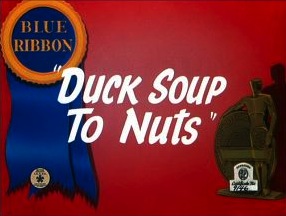
Duck Soup to Nuts is a 1944 Warner Bros. Looney Tunes cartoon directed by Friz Freleng. The cartoon was released on May 27, 1944, and stars Daffy Duck and Porky Pig.

Dough for the Do-Do is a 1949 Warner Bros. Merrie Melodies cartoon directed by Friz Freleng. The short was released on September 2, 1949, and stars Porky Pig. The short is a remake of Bob Clampett's 1938 cartoon Porky in Wackyland, as well as using footage from his 1943 cartoon Tin Pan Alley Cats.

Drip-Along Daffy is a 1951 Warner Bros. Merrie Melodies theatrical cartoon short, directed by Chuck Jones and written by Michael Maltese. The cartoon was released on November 17, 1951, and stars Daffy Duck and Porky Pig.

A Corny Concerto is a 1943 Warner Bros. Merrie Melodies directed by Bob Clampett. The short was released on September 25, 1943, and stars Bugs Bunny, Porky Pig, Elmer Fudd and Daffy Duck.
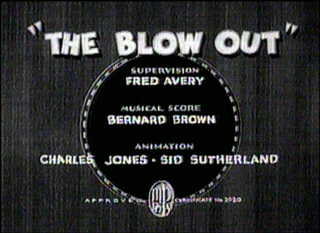
The Blow Out is a 1936 Warner Bros. Looney Tunes animated short film directed by Tex Avery. The short was released on April 4, 1936, and is the first Porky Pig solo cartoon.

Claws for Alarm is a 1954 Warner Bros. Merrie Melodies cartoon directed by Chuck Jones. The short was released on May 22, 1954 and stars Porky Pig and Sylvester.
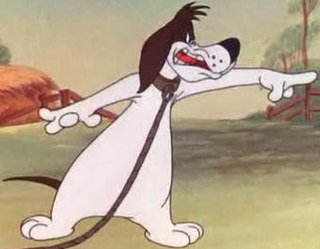
Barnyard Dawg is a Looney Tunes character. A feisty anthropomorphic basset hound, he is a friend and the archenemy of Foghorn Leghorn. He was created by Robert McKimson, who also created Foghorn, and was voiced by Mel Blanc. Dawg also feuds with other enemies as well like Henery Hawk, Daffy Duck and Sylvester. He appeared in 23 Golden Age–era Warner Bros. shorts.
Trap Happy Porky is a 1945 Warner Bros. Looney Tunes short directed by Chuck Jones and written by Tedd Pierce. The short was released on February 24, 1945, and features Porky Pig, along with Hubie and Bertie, an early version of Claude Cat and a prototype of Hector the Bulldog.

New Looney Tunes is an American animated television series from Warner Bros. Animation based on the characters from Looney Tunes and Merrie Melodies. The series debuted on January 26, 2015, on Cartoon Network, and continued with new episodes beginning on March 14, 2015, on Boomerang. Part way through the first season, new episodes would premiere on Boomerang's video on demand service before airing on television.

Looney Tunes: Rabbits Run is a 2015 American animated direct-to-video adventure comedy film in the Looney Tunes franchise produced by Warner Bros. Animation. It is the first new Looney Tunes direct-to-video film since Bah, Humduck! A Looney Tunes Christmas was released nine years prior. The film was made shortly after The Looney Tunes Show, and shares much of the same crew as that series, including director Jeff Siergey, who had also been a supervising animator on Space Jam and lead animator on Looney Tunes: Back in Action. It was released on August 4, 2015, by Warner Bros. Discovery Home Entertainment, but it was released early on July 7, 2015 on Vudu and Walmart.
References
- ↑ Beck, Jerry; Friedwald, Will (1989). Looney Tunes and Merrie Melodies: A Complete Illustrated Guide to the Warner Bros. Cartoons. Henry Holt and Co. p. 196. ISBN 0-8050-0894-2.
- ↑ Lenburg, Jeff (1999). The Encyclopedia of Animated Cartoons. Checkmark Books. pp. 124–126. ISBN 0-8160-3831-7 . Retrieved 6 June 2020.